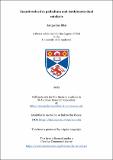Files in this item
Enantioselective palladium and isothiourea dual catalysis
Item metadata
| dc.contributor.advisor | Smith, Andrew David | |
| dc.contributor.author | Bitai, Jacqueline | |
| dc.coverage.spatial | xiii, 256 p. | en_US |
| dc.date.accessioned | 2022-05-17T09:50:51Z | |
| dc.date.available | 2022-05-17T09:50:51Z | |
| dc.date.issued | 2022-06-15 | |
| dc.identifier.uri | https://hdl.handle.net/10023/25385 | |
| dc.description.abstract | This thesis details the development of dual catalytic processes involving achiral palladium and enantiopure isothiourea catalysts for the synthesis of enantioenriched and highly functionalised products. Taking inspiration from related literature examples demonstrating the compatibility of palladium and isothiourea catalysis, the extension of existing methodologies as well as the development of novel processes were investigated. Based on the relay catalytic allylic amination/[2,3]-rearrangement protocol, previously developed in our group for the synthesis of enantioenriched α-amino ester derivatives, the scope and limitations of this process were probed. Initial studies aimed at identifying functional groups that could be tolerated in the relay catalysis. Electron-withdrawing amide substituents proved most promising and were explored in more depth to furnish enantioenriched α-amino ester derivatives featuring a 1,4-dicarbonyl motif. As processes reported so far had focused on ammonium enolates as reaction partners, the range of reactivity modes accessible by isothiourea catalysis had not been fully exploited in dual catalytic methodologies. As such, the development of a cooperative palladium and isothiourea catalysis process employing α,β-unsaturated acyl ammonium intermediates was explored. This process furnishes enantioenriched cyclopentane products with up to four contiguous stereogenic centres with high stereoselectivity (up to 99:1 dr, up to 97:3 er). The scope and limitations of this process were probed, with subsequent derivatisation reactions demonstrating the synthetic utility of the products. In addition, a range of control experiments provided insight into the mechanism of this cooperative palladium and isothiourea catalysis. | en-US |
| dc.language.iso | en | en_US |
| dc.relation | Enantioselective Palladium and Isothiourea Dual Catalysis (Thesis Data) Bitai, J., University of St Andrews, 1 Apr 2024. DOI: https://doi.org/10.17630/da9d96a3-9199-41a5-a06b-20a9686ed96d | en |
| dc.relation.uri | https://doi.org/10.17630/da9d96a3-9199-41a5-a06b-20a9686ed96d | |
| dc.rights | Creative Commons Attribution-NonCommercial-NoDerivatives 4.0 International | * |
| dc.rights.uri | http://creativecommons.org/licenses/by-nc-nd/4.0/ | * |
| dc.subject | Isothiourea | en_US |
| dc.subject | Palladium | en_US |
| dc.subject | [2,3]-rearrangement | en_US |
| dc.subject | Formal (3+2) cycloaddition | en_US |
| dc.subject | Allylic substitution | en_US |
| dc.subject | Enantioselective dual catalysis | en_US |
| dc.subject.lcc | QD505.B5 | |
| dc.title | Enantioselective palladium and isothiourea dual catalysis | en_US |
| dc.type | Thesis | en_US |
| dc.contributor.sponsor | University of St Andrews. School of Chemistry | en_US |
| dc.type.qualificationlevel | Doctoral | en_US |
| dc.type.qualificationname | PhD Doctor of Philosophy | en_US |
| dc.publisher.institution | The University of St Andrews | en_US |
| dc.rights.embargoreason | Embargo period has ended, thesis made available in accordance with University regulations | en |
| dc.identifier.doi | https://doi.org/10.17630/sta/169 |
The following licence files are associated with this item:
This item appears in the following Collection(s)
Except where otherwise noted within the work, this item's licence for re-use is described as Creative Commons Attribution-NonCommercial-NoDerivatives 4.0 International
Items in the St Andrews Research Repository are protected by copyright, with all rights reserved, unless otherwise indicated.


